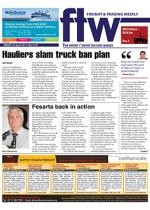Proposed regulations
banning trucks over 9 tons
from all public roads during
rush hour will not just have
a drastic effect on the freight
industry but will increase
transport and logistics
costs significantly, said
Road Freight Association
spokesman Gavin Kelly.
Minister of Transport,
Dipuo Peters, last week
announced that new
regulations restricting goods
vehicles with a gross vehicle
mass (GVM) exceeding
9000kg from operating on
public roads between 6-9am
as well as 5-8pm weekdays
would be implemented by the
end of the year.
“The proposed legislation
is ill-conceived and not
clearly thought through
and will damage logistics,
raising costs and causing
severe bottlenecks in the
logistics chain,” he said. “Just
as worrying is the fact that
these comments around the
introduction of regulations
are being made without any
public comment or industry
input.”
Already in their draft
phase, it is believed the
minister aims to have the
regulations implemented by
the end of the year.
“It would seem irrespective
of what anyone says these
regulations are going to
be introduced,” said Kelly,
who confirmed the RFA
was obtaining legal counsel
on the matter. “We are also
going to be engaging urgently
with the Minister’s office
in an effort to get clarity
on several issues, including
why the Minister is choosing
to restrict freight on these
specific days and at these
proposed times. What is the
basis for these restrictions?”
Kelly said the Department
of Transport would be
asked to not only provide
information supporting
its proposal but also the
research conducted to
determine the effect these
regulations would have
on traffic flow, freight
movement and scheduling, to
name but a few.
“This is not just affecting
the trucking industry but
a host of other sectors –
retailing, manufacturing
and warehousing will have to
re-examine their operations
because trucks have been
taken out of operation for six
hours a day,” he said.
The restriction is also
being applied for public roads
across the country.
“That means trucks are not
moving on the N3 between
Durban and Johannesburg
during those hours. Does
the truck now only leave
the port at 9am en route to
Johannesburg for example?
Where does it go at 5am
when it has not yet arrived at
its final destination? Do the
drivers park on the side of the
road? What is the security
risk of this and has it been
determined? Who carries the
cost of overtime of workers
at depots, warehouses,
retail outlets and the host
of other industries affected,
not to speak of the drivers?”
he asked. “To make up the
time lost during the day are
we going to increase truck
activity at night? Is that a
safer option than the day
in light of the fact that the
reasoning for this regulation
is less road carnage?”
In a statement Peters said
a spate of truck accidents and
the increasing road carnage
on South African roads had
led to the initiative.
While several accidents
involving trucks have made
headlines in the past few
months, organisations such
as the RFA are querying this
saying there has hardly been
a “spate” of accidents.
Kelly says it is a
misconception that trucks
are responsible for road
carnage.
“In fact statistics on the N3
show that accidents involving
trucks have decreased in
recent months,” he said.
The new regulations do
not apply to fire-fighting
vehicles, emergency medical
response vehicles, rescue
vehicles or ambulances.
The DoT confirmed the
regulations had not been
published but said they were
already in draft form and
would soon be presented
to Parliament before being
published, like all other
legislation and regulations, for
public comment and discussion.
INSERT & CAPTION
Does the truck now
only leave the port
at 9am en route to
Johannesburg?
– Gavin Kelly

